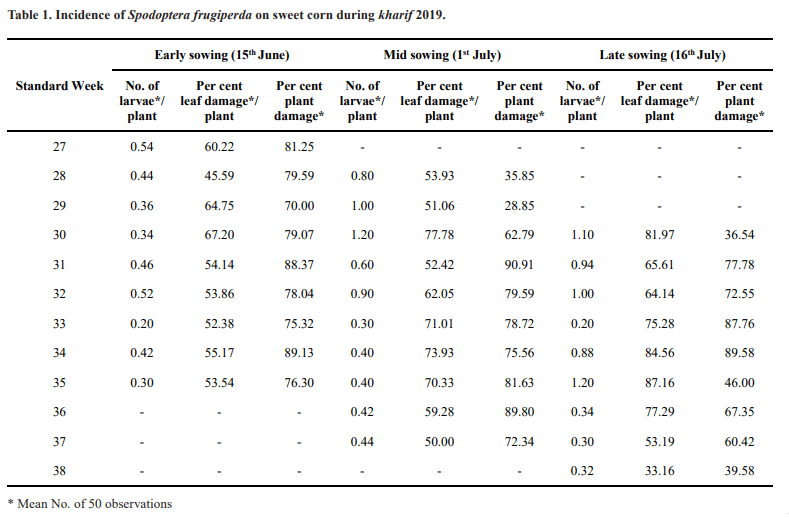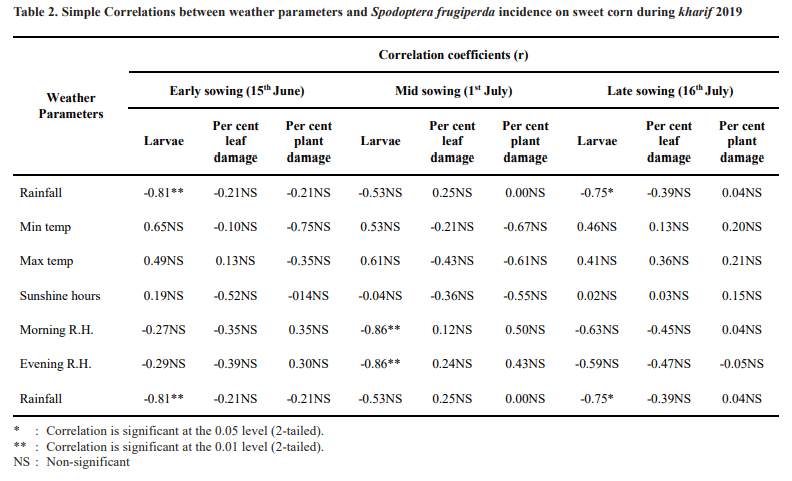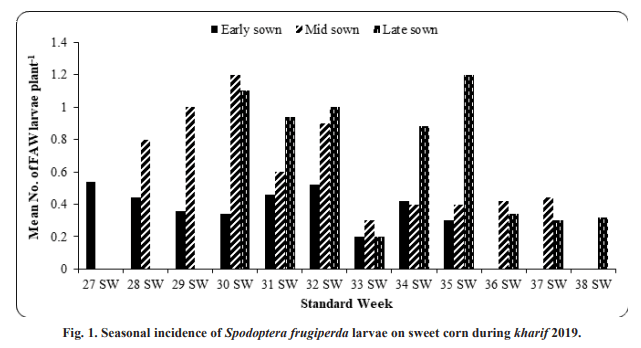Seasonal Incidence of Fall Armyworm Spodoptera Frugiperda (J.e. Smith) In Sweet Corn
0 Views
M. LAVAN KUMAR REDDY*, A. RAJESH, K.V. HARI PRASAD AND B. RAMANA MURTHY
Department of Entomology, S.V. Agricultural College, ANGRAU, Tirupati
ABSTRACT
Seasonal incidence of Spodoptera frugiperda (J.E. Smith) on sweet corn was carried out during Kharif, 2019 at dry land farm, S.V. Agricultural College, Tirupati with three dates of sowing at fortnightly intervals starting from June 15th. Incidence of
S. frugiperda was low in early sown crop (June 15th) when compared to the mid (July 1st) and late sown crop (July 16th). A significant negative correlation was observed between S. frugiperda incidence and rainfall in early sowing. In mid sowing
S. frugiperda exhibited negative correlation with morning and evening relative humidity (R.H). The population of S. frugiperda in late sown crop exhibited significant negative correlation with rainfall. Per cent leaf damage and plant damage was low in early sown crop compared to mid and late sown crop. The present result revealed that early sowing (15 days) of sweet corn will reduce the incidence and damage of S. frugiperda in sweet corn.
KEY WORDS:
Corn, fall armyworm, seasonal incidence, Spodoptera frugiperda.
INTRODUCTION
Maize (Zea mays L.) is a miracle crop emerging as the third most important cereal crop next to rice and wheat. Maize is called “Queen of Cereals” because of its productivity potential (22 t ha-1) relative to any other cereal crop (Parihar et al., 2011). Sweet corn (Zea mays saccharata Sturt) is one type of maize which contains 13 to 15 per cent sugar in immature grains is of short duration, picked when immature (milk stage) and eat as a vegetable rather than as a grain.
Among the insect pests attacking sweet corn S. frugiperda (J.E. Smith is most important recent pest whose damage may extent from 20 per cent to 80 per cent. The fall armyworm (FAW), S. frugiperda) is native to the tropical regions of the western hemisphere from the United States to Argentina. It is primarily a pest of maize but has a wide host range and is capable of feeding on over 80 plant species, periodically causing significant economic damage to maize, rice, sorghum, millet, soybean, wheat, alfalfa, cotton, turf, and fodder crops (Pogue, 2002).
The FAW was first noticed in the Indian subcontinent at Bangalore Rural and Chikkaballapur district during May and June 2018 (Ganiger et al., 2018) and South Karnataka during the first fortnight of July 2018 (ICAR-NBAIR pest alert, 2018) and it was also observed in Andhra Pradesh during august 2018 (Venkateswarlu et al., 2018). FAW larvae can damage maize crop at various stages of development by feeding on leaf or ear tissues. The foliage damage is generally typical and feeding on ears can be noticed under heavy infestations. The larva can be found in the whorl feeding on young leaves at 13 days (Harrison, 1986), 14 to 21 days after sowing (Melo and Silva, 1987).
Depending on the growth stage of maize, fall armyworm larvae are found on young leaves, leaf whorls, tassels or Cobs (Goergen et al., 2016). Infestation during the mid- to late-whorl stage of maize development caused yield losses of 15-73 per cent when 55-100 per cent of the plants were infested with S. frugiperda (Hruska and Gould, 1997).
According to the recent studies, fall armyworm can cause yield losses ranging from 8.3 to 20.6 million tonnes of maize in absence of management practices (Day et al., 2017).
Temporal distribution of insect pests is often governed by complex interactions exerted by abiotic and biotic factors. As S. frugiperda is a new pest to Andhra Pradesh, there is every need to know the impact of dates of sowing on the population dynamics of the pest.
Therefore, information pertaining to seasonal abundance of the S. frugiperda would be beneficial while combating with the pest, to keep its populations below damaging levels.
MATERIAL AND METHODS
Field trails were conducted to know the seasonal incidence of fall armyworm on sweet corn at the dry land farm, S.V. Agricultural College, Tirupati during Kharif, 2019 with three sowing dates, at 15 days interval starting from June 15th (early) followed by July1st (mid) and July 16th (late). Three plots of each 100 m2 were raised with a spacing of 60 x 20 cm.
The data on incidence of fall armyworm, plant and leaf damage was collected from all plants in 5 randomly selected quadrants at weekly intervals during different phases of crop growth in the experimental plots. The data was correlated with the weather parameters viz., maximum and minimum temperature, morning and evening relative humidity, rainfall and sunshine hours so as to infer the impact of abiotic factors on build-up of the pest.
RESULTS AND DISCUSSION
The present results showed that incidence of S. frugiperda started from 12-17 days after sowing and attained peak at 25-45 days after sowing (Fig. 1) in all the three dates of sowing (early, mid and late) of sweet corn the and remained on the crop till harvest. The present findings are in agreement with Vijaaakshaya et al.(2020) who reported that incidence of S. frugiperda was maximum in second fortnight of July (30-45days after sowing). In early sowing, the S. frugiperda incidence started at 27 SW and continued till the 35 SW with peak incidence between 27 to 28 SW (0.54 larvae/plant) (Table
1) and then decreased gradually up to 31 SW and again increased after 31 SW (Fig. 1). In mid sowing, S. frugiperda incidence started from 28 SW and continued till the 37 SW with peak incidence at 30 SW 1.2 larvae/ plant (Table 1), (Fig. 1). In late sowing, S. frugiperda incidence started from 30 SW and continued up to 38 SW with peak incidence at 35 SW 1.2 larvae/plant (Table 1), (Fig. 1). Similar results were also reported by Annandhi et al. (2020) with larval population peak at 27 SW. The present results are line with the findings of Rojas et al. (2004) who reported that peak activity of
S. frugiperda during June to September. The percent leaf damage was maximum at 30 SW in early sowing (67.20%)
(Table 1) followed by mid sowing (77.78) (Table 1) at 30 SW and late sowing (87.16%) at 35 SW (Table 1).
The percent plant damage was maximum at 34 SW in early sowing (89.13%) (Table 1), 31 SW in mid sowing (90.91%) (Table 1) and at 34 SW (89.58%) in late sowing (Table 1). The results of the correlation studies revealed that S. frugiperda incidence exhibited a significant and negative correlation with the rain fall in early sowing (Table 2). Increased temperature and sunshine hours might have favoured the higher rate of photosynthesis of sweet corn which in turn favoured the continuous and abundant food supply to fall armyworm larvae. Similar results were reported by Vijaaakshaya et al. (2020) who reported that
S. frugiperda incidence had significant and negative correlation with the rainfall, relative humidity and positive correlation with maximum and minimum temperatures.
In mid sowing, S. frugiperda population exhibited a significant negative correlation with morning and evening
R.H. (Table 2). In late sowing, S. frugiperda exhibited a significant negative correlation with rainfall (Table 2). Waddill et al.(1981) reported that heavy and light rainfalls kill significant number of early instar of S. frugiperda showing negative correlation with rainfall. The percent leaf and plant damage varied with different dates of sowing and lowest per cent leaf and plant damage was observed in early sowing compared to mid and late sowing.
CONCLUSION
The low incidence of S. frugiperda in early sown crop resulted in less cob damage compared to mid and late sown crop. The correlation studies between S. frugiperda incidence and weather parameters revealed that population of S. frugiperda decreased with increase in rainfall and relative humidity. Increased temperature and sunshine hours in mid and late sown crops might have favoured the higher rate of photosynthesis of sweet corn which in turn favoured the continuous and abundant food supply to fall armyworm larvae resulting in higher incidence of larvae and higher leaf and plant damages. The percent leaf and plant damage varied with different dates of sowing and lowest per cent leaf and plant damage was observed in early sown corn. Hence early sowing of sweet corn can be recommended to avoid high incidence of S. frugiperda and to get higher yields.



ACKNOWLEDGEMENT
We are thankful to the Department of Entomology and farm superintendent of S.V. Agricultural college , Tirupati for the timely help in conducting this study. This study is a part of M.Sc. Thesis of the first author.
LITERATURE CITED
Anandhi, S., Saminathan, V.R., Yasotha, P., Sharavanan, P.T and Venugopal Rajanbabu. 2020. Seasonal dynamics and spatial distribution of fall armyworm Spodoptera frugiperda (J.E. Smith) on Maize (Zea mays L.) in Cauvery Delta Zone. Journal of Pharmacognosy and Phytochemistry. 9(4): 978-982.
Day, R., Abrahams, P., Bateman, M., Beale, T., Clotte, V and Cock, M. 2017. Fall Armyworm: Impacts and Implication for Africa. Outlooks on Pest Management. 28(5): 196-201.
Ganiger, P.C., Yeshwanth, H.M., Muralimohanvinayak, N.A., Kumar, R.V., Chandrashekara, K. 2018. Occurrence of the new invasive pest, fall armyworm, Spodoptera frugiperda (J.E. Smith) (Lepidoptera : Noctuidae), in the maize fields of Karnataka, India. Current Science. 115(4): 621-623.
Goergen, G., Kumar, P.L., Sankung, S.B., Togola, A and Tamò, M. 2016. First report of outbreaks of the fall armyworm Spodoptera frugiperda (J.E. Smith) (Lepidoptera : Noctuidae), a new alien invasive pest in west and Central Africa. PLoS ONE. 11(10): 56-59.
Harrison, F.P. 1986. Fall armyworm (Lepidoptera : Noctuidae): potential for area-wide management. Florida Entomologist. 69(3): 487-491.
Hruska, A and Gould, F. 1997. Fall Armyworm (Lepidoptera : Noctuidae) and Diatraealineolata (Lepidoptera : Pyralidae): impact of larval population level and temporal occurrence on maize yield in Nicaragua. Journal of Economic Entomology. 90(2): 611-622.
ICAR-NBAIR, 2018. Pest Alert: 30th July, 2018. Spodoptera frugiperda (Smith J.E.) (Insecta : Lepidoptera), India: ICARNBAIR.
Melo, M and Silva, R.F.P. 1987. Influência de trêscultivares de milho no desenvolvimento de Spodoptera frugiperda (J.E. Smith, 1797) (Lepidoptera : Noctuidae). Anais da Sociedade Entomológica do Brasil. 16(2): 37-49.
Parihar, C.M., Jat, S.L., Singh, A.K., Kuma, R.S., Hooda,
K.S and Singh, D.K. 2011. Maize production technologies in India, 2011.
Pogue, G.M. 2002. A world revision of the genus Spodoptera Guenée (Lepidoptera : Noctuidae). American Entomological Society. 43(9): 1-202.
Rojas, J.C., Armando, V and Malo, E.A. 2004. Seasonal and nocturnal flight activity of Spodoptera frugiperda males (Lepidoptera : Noctuidae) monitored by pheromone traps in the coast of chiapas, Mexico. Florida Entomologist. 87(4): 496-503.
Venkateswarlu, U., Johnson, M., Narasimhulu, R and Muralikrishna, T. 2018. Occurrence of the fall armyworm, Spodoptera frugiperda (J.E. Smith) (Lepidoptera : Noctuidae), a new pest on bajra and sorghum in the fields of agricultural research station, Ananthapuramu, Andhra Pradesh, India. Journal of Entomology and Zoology Studies. 6(6): 811-813.
Vijayaakshaya Kumar, N., Yasodha, P and Justin, C.G. 2020. Seasonal incidence of maize fall armywom (Noctuidae : Lepidoptera) in Perambalur district of Tamil Nadu, India. Journal of Entomology and Zoology Studies. 8(3): 1-4.
Waddill, V.H., Mitchell, E.R., Denton, W.H., Poe, S.L and Schuster, D.J. 1982. Seasonal abundance of the fall armyworm and velvet bean caterpillar (Lepidoptera : Noctuidae) at four locations in Florida. Florida Entomologist. 11(1): 350-354.
- Genetic Divergence Studies for Yield and Its Component Traits in Groundnut (Arachis Hypogaea L.)
- Correlation and Path Coefficient Analysis Among Early Clones Of Sugarcane (Saccharum Spp.)
- Character Association and Path Coefficient Analysis in Tomato (Solanum Lycopersicum L.)
- Survey on the Incidence of Sesame Leafhopper and Phyllody in Major Growing Districts of Southern Zone of Andhra Pradesh, India
- Effect of Organic Manures, Chemical and Biofertilizers on Potassium Use Efficiency in Groundnut
- A Study on Growth Pattern of Red Chilli in India and Andhra Pradesh

